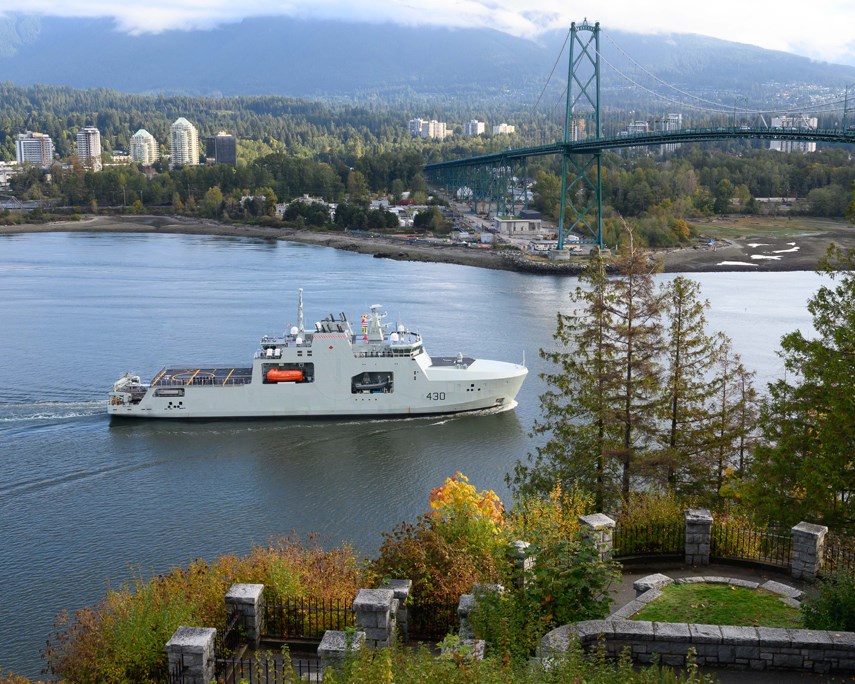For the first time in 50 years, a Canadian naval ship has crossed the Northwest Passage. And HMCS Harry DeWolf tied up to Burrard Dry Dock Pier in North Vancouver on Friday morning (Oct. 1).
“It was a really big deal for the Canadian Navy and for everybody that was associated to the project, to really kind of give each other a slap on the back and say, yeah, we did it. We finally brought a naval vessel with all of its complicated systems into service and it was robust enough that it could actually perform and stay up North,” said Cmdr. Corey Gleason. “We did it on one tank of gas.”
HMCS Harry DeWolf is the first of six Arctic offshore patrol vessels built under Canada’s National Shipbuilding Strategy. It’s about the length of a football field (CFL, of course, not NFL) and 19 metres wide. It stands about six storeys from the waterline.
“So it's a really big ship,” Gleason said. “It's the largest Canadian warship purposely built for the Canadian Navy in 50 years.”
Apart from some early hiccups at launch, Gleason said the ship was more than capable of traversing the high arctic. Officially, it is to patrol but it also should hold its own in a scrap, with 25-millimetre and 50-calibre guns, and a hanger for launching Cyclone helicopters.
Its current mission, Operation Nanook Tuugaalik, is something of an introductory tour, to demonstrate its capabilities, but also for northern communities, the West Coast public, shipbuilding firms and naval crews based in Esquimalt to get to know their new ship, Gleason said.
“This was the first time to get up there and introduce the ship to the region and just kind of say hello,” he said. “We're here to show the ship off a little bit, to the public, of course, but also to do business with our contractors.”
On their way, Harry DeWolf anchored not far from where the famed 1845 Franklin Expedition ended in tragedy. There, the crew contemplated the challenge of crossing the Northwest Passage 175 years ago and paid their respects at a local graveyard.
“It was a really gut wrenching experience for a lot of them to know that fellow sailors had suffered such hardships there,” he said.
And we are here! @HMCSHarryDeWolf is alongside the Burrard Dry Dock Pier in #NorthVan pic.twitter.com/xz5i8KMVVs
— Rear-Admiral of the Red (@AngusTopshee) October 1, 2021
Apart from being a place to rest and go on dry land, the North Shore has another connection to the Gleason’s mission and the Northwest Passage.
RCMPV St. Roch, the first Canadian ship to cross the Northwest Passage, was built and launched at the original Burrard Dry Dock in 1928, just metres away from where they docked.
Gleason said he could remember the original shipyard (which has since been replaced by the City of North Vancouver’s more people-oriented Shipyards District) from his time stationed on the West Coast. But he did not know the connection to the St. Roch, which has a special place in his heart and aboard his ship.
“I have a design of St. Roch’s hull carved out of wood in my cabin. It was presented to me by Admiral Davidson (retired) just before I left, to commemorate this voyage. It's just a beautiful thing,” he said. “I share it with everybody that comes in.”
The St. Roch is the feature exhibit in the Vancouver Maritime Museum, where a few of Gleason’s crew were planning to visit on their stay.
HMCS Harry DeWolf is scheduled to leave for Victoria on Sunday where it will go through two weeks of rest and maintenance before heading south to join United States Armed Forces in operations to counter drug smuggling. After it transits the Panama Canal, it will return to Halifax, circumnavigating North America, just as St. Roch had done 71 years ago.
The public is invited to come check out HMCS Harry DeWolf on Friday and Saturday, although due to COVID-19, tours aboard are not being done.



